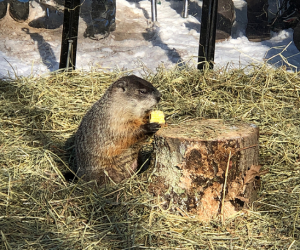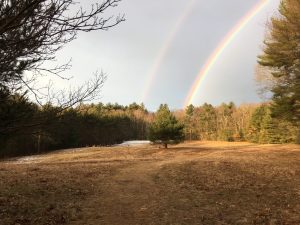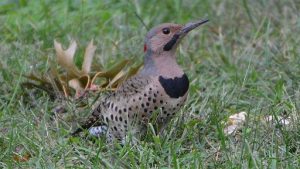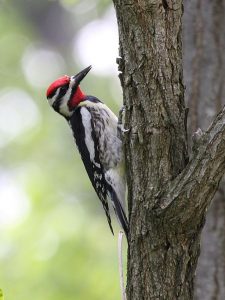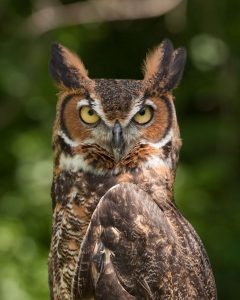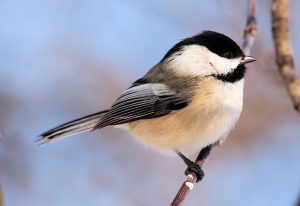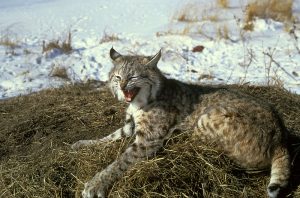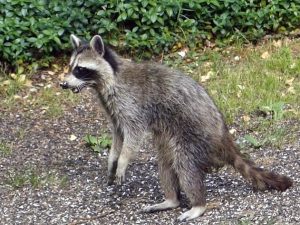Written by Gwyn Loud for the Lincoln Land Conservation Trust. She welcomes your sightings (pictures too!) and questions, at 781-259-8690 or gwynloud555@gmail.com.
The weather over the past month has taken us on a roller coaster, from 0 ℉ on January 31 to 63 ℉ in early afternoon just four days later. Now we seem to be back in a more normal range for this time of year, although the word “normal’ is now losing its meaning! As usual on February 2, Groundhog Day, Ms. G, the official Massachusetts groundhog (aka woodchcuck) residing at Drumlin Farm, made an appearance to see if she could see her shadow. She did, which supposedly predicts that we will have six more weeks of winter. We’ll find out. A beautiful weather event occurred on February 5 when many of us witnessed a gorgeous double rainbow to the west at 7:30 AM, an unusual time of day for a rainbow in my experience.
Recent bird sightings of note include an Eastern towhee feeding on the ground under bird feeders by a house on Beaver Pond Rd. Towhees are no longer common, and certainly not at this season. Two hardy individuals of woodpecker species which usually overwinter farther south were reported: a Northern flicker in woods near Winter St., and a yellow-bellied sapsucker at Drumlin Farm. A turkey vulture and a winter wren were seen, also species which we would not expect to see before spring. A number of people have seen bald eagles overhead. After disappearing as a breeding bird in Massachusetts in the early 1900s, bald eagles have made a big comeback thanks to restoration efforts starting in 1982. Even though eagles are increasing in number, they are still protected under the Massachusetts Endangered Species Act. Other raptors reported include red-tailed hawks, which can be seen year-round soaring over fields, a sharp-shinned hawk, and Cooper’s hawks, which often frequent bird feeding areas. Wing prints in the snow and piles of feathers are evidence of hawk activity and dining. A Woods End Road resident found a headless vole carcass on top of a bird house where a red-tailed hawk often perches. It is common for the heads of prey to be eaten first because the brains are especially nutritious.
Many barred owls have been seen and heard (“Who cooks for you all”) from different parts of town. They are both nocturnal and diurnal feeders and seem unperturbed as they perch in trees with people passing nearby. Great-horned owls are also hooting a lot at this season; one can often hear the higher-pitched call of the female answering the lower pitched male. They are our earliest nesters of the season, using an abandoned old stick nest of another bird. By now the eggs are probably laid, with the female doing much of the incubation.
The sun is higher in the sky each day and the hours of daylight are extending, giving promise of spring to come. Willows are yellowing and one observer saw skunk cabbage poking up in a wetland as early as January 1. Various birds are starting to give their spring songs, triggered by daylight length rather than weather. Listen for the “fee-bee” call of the chickadee, the drumming of woodpeckers, and the chattering of house finches. Male American goldfinches are already showing hints of molting to their breeding plumage of canary-below. By the end of February we can expect the first red-winged blackbirds to arrive, giving their nasal “conk-a-ree” calls.
Birders who would like to participate in the annual Great Backyard Bird Count on Feb. 15-18 should check www.birdcount.org. It involves counting the birds you see for at least fifteen minutes on one or more days of the count and entering your list on the website. This citizen-science project collects sightings from around the world.
Mammals reported recently include several fishers, coyotes, raccoons, and white-tailed deer. Meadow vole tunnels were very obvious in fields, lawns and gardens in the recent shallow snow. There was a possible sighting of a bobcat, a mammal which is increasing in New England. Bobcats are two-three times the size of a house cat and have a short bobbed tail. Watch for gray squirrels doing mating chases, with two or more males chasing a female. The result will be three-five young born in a tree cavity after a 45-day gestation period.
Looking to the skies, we can look forward to the full Snow Moon on February 18-20. This full moon is the most super of three super moons in 2019, so named when the full moon is closest to earth in the moon’s monthly elliptical orbit and looks a bit bigger than usual. The bright star we will see near the moon is Regulus, in the constellation Leo. Mercury is the most difficult naked-eye planet to see as it is closest to the Sun but on February 26 it will be at its highest point just after evening twilight. You can find it about eight degrees (three finger widths) above the horizon in the west
© Gwyn Loud


